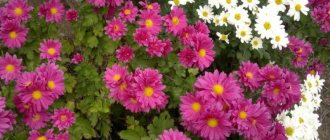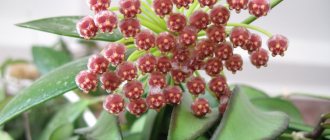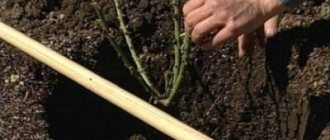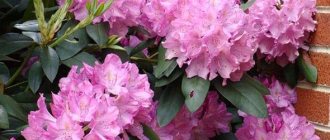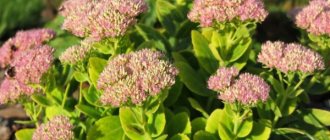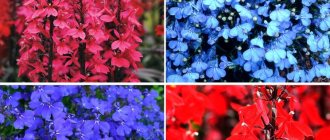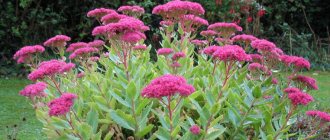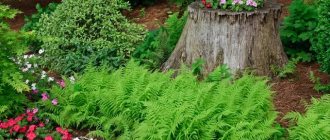Garden Tradescantia bushes help create beautiful voluminous thickets in the garden plot. Such bushes are planted close to ferns, daylilies, and irises. Tall varieties of perennials are recommended to be planted in dachas and gardens near water bodies.
Botanical features
Absolutely all types of Tradescantia are perennial herbaceous plants with relatively thin, creeping stems that take root very easily at the nodes. The foliage of the plant is quite small, oblong and pointed. The main foliage color is green or green with white or yellow stripes. The surface of the leaves can be either smooth or pubescent. Variegated species are classified into the genus Zebrina.
Flowering is quite abundant. The plant produces flowers of purple, reddish, deep blue, blue or white color. Flowers are collected in simple-type, umbellate or paniculate inflorescences. Rarely can a flower be single. The corolla of a flower may have three petals. Flowering is observed from the first ten days of summer until the onset of autumn , which guarantees long and continuous flowering.
Possible problems
- Tradescantia grows poorly . The shoots become elongated, and the amount of foliage is reduced due to lack of water or nutrients, as well as due to poor lighting.
- Tradescantia leaves turn green . When growing variegated forms, you need to make sure that the flower has enough light, otherwise its foliage will turn green.
- Spots on leaf blades . If the plant does not have enough water, then because of this its shoots will become sluggish, and yellow spots will form on the surface of the leaf blades.
- The flower stretches out . During the winter period, the shoots of Tradescantia can stretch out, while the foliage at their base dries and flies off. In this case, rooted cuttings are used to rejuvenate the bush.
- Tradescantia leaves turn brown . If the air humidity is too low, the tips of the leaf blades may turn brown.
- The foliage becomes monochromatic . Sometimes the stripes disappear on the sheet plates and they become monochromatic. This happens due to too little lighting, and also if pruning or cuttings were carried out incorrectly.
Diseases and pests
Most often, such a flower is affected by rot. If he is on the street, then slugs and aphids can harm him.
Types and varieties
Today, about a hundred species of this ornamental plant are known, but in the conditions of home gardening, only a few of them are most widespread. All varieties and species differ in the size and shape of the shoots , as well as the appearance and color of the flowers and the duration of flowering. The perennial crop is quite unpretentious, and its cultivation in open ground makes it very easy to create interesting and spectacular flower arrangements.
| Species name | Variety name | Description of the plant |
| Tradescantia virginiana | Coerulea | Shoots with green, medium-sized leaves. Light blue flowers |
| Rubra | Relatively powerful shoots with emerald lanceolate leaves. The flowers are small in size, ruby-reddish in color. | |
| Atrorubra | A highly decorative variety with attractive soft green foliage. Flowers of rich bright red color | |
| Rosea | Shade-tolerant variety with characteristic green foliage. Delicate pinkish flowers | |
| Anderson's Tradescantia (Tradescantia x andersoniana) | J.G.Weguelin | The height of the plant varies between 50-70 cm, the flowers are sky blue, very large in size, bright, with crimson-violet pedicels. The leaves have a bluish coating |
| Iris | The variety is characterized by bright green foliage and long-lasting flowering with deep blue flowers. | |
| Bilberry Ice | A plant up to 50 cm high, with large, raspberry-pink flowers with a white rim along the edges of the petals. | |
| Blue and Gold | The flowers are purple, medium in size, with leaves and stems of golden yellow or reddish yellow color. | |
| Blue Stone | A plant 60-70 cm high, with green leaves and blue-blue flowers slightly corrugated along the edges. | |
| Concord Grape | A powerful and tall plant with bluish-gray foliage and very small, numerous violet-purple flowers. | |
| Osprey | Plant up to 70 cm high, with white, very large flowers and slightly wavy petals | |
| Pink Chables | The foliage is green, the flowers are light pink. There is a white border and bright pink filaments | |
| Purple Profusion | The stems form a rounded bush 45-55 cm high, with dark purple flowers. | |
| Anyuta | Stems up to 30-40 cm high, with green leaves and large raspberry-pink flowers with rounded and slightly corrugated petals |
Domestic amateur gardeners most often grow the following popular varieties and hybrid forms of garden tradescantia:
- white-flowered varieties “White Pupa and Innocence;
- white-flowered variety with golden foliage “Angelik Charm”;
- purple-flowered variety "Carminglut";
- variety “Ruddy Bride” with orchid-shaped flowers of delicate pearlescent color;
- purple-flowered variety "Sunshine Charm" with yellow-green leaves;
- variety with double blue flowers “Max Double”.
Description of the flower
Tradescantia belongs to the Commelinaceae family. Typically, these are evergreen perennial herbaceous shrubs that form dense rows along the edges of warm, humid tropical forests.
This flower is a system of several straight or creeping stems, covered with leaves of various shapes and colors - white, green, blue, gray, red and almost purple. Tradescantia leaves are arranged alternately and have different shapes depending on the species: saber-shaped, lanceolate, elliptical or ovoid. Inflorescences form in the axils of the apical leaves.
This may be interesting: Monstera - caring for a beauty with a scary name
The lifespan of a flower is 7-10 years or more, which is a long time for indoor plants. The height of a bush at home can be up to 30 cm, or twice as high. In the wild, shrubs grow up to a meter in height. The growth rate is high, sometimes up to 30 cm per year.
In indoor culture they are usually classified as decorative foliage plants, but some species, or rather their hybrids, bloom beautifully. Tradescantia blooms in summer, from July to August. In indoor floriculture it is often used as an hanging crop.
Landing technology
Planting perennial tradescantia in open ground flower beds must be carried out in accordance with the following recommendations:
- Tradescantia in open ground needs a very sunny or lightly shaded area, without through and gusty winds;
- It is optimal to grow ornamental crops near bodies of water;
- the soil on the site for growing Tradescantia should be fertile, fairly light, with slightly acidic properties;
- the soil in flower beds should not only be light in composition, but also have optimal air permeability and water permeability;
- The best soil composition for growing Tradescantia is based on turf and leaf soil, sand and humus.
It is important to note that in addition to aesthetic qualities, almost all types of Tradescantia are distinguished by the presence of the following medicinal properties:
- antibacterial effect;
- beneficial effect on the respiratory system;
- prevention of colds;
- treatment and prevention of periodontal disease;
- prevention of certain gastrointestinal diseases;
- prevention and treatment of furunculosis.
Thus, growing garden tradescantia is a very useful activity and not particularly difficult. Outdoor ornamental crops practically do not cause problems for gardeners, are frost-resistant, and are extremely rarely damaged by pests and pathogenic microflora.
Air temperature
Temperature cannot be called a key parameter for the favorable existence of saxifrage. The flower is quite resistant to both summer heat and winter cold.
However, this should not be taken literally. It is not advisable to intentionally expose saxifrage to extreme temperatures.
Care instructions
The ornamental crop is not demanding in care, but in order to maintain its visual appeal, certain conditions must be observed for optimal growth and flowering, especially this rule concerns the composition of the soil and moisture levels:
- in temperate and warm climatic conditions, garden tradescantia are able to winter in open ground without the use of shelter;
- in cold climates and regions with little snow and low temperatures, plants require covering with polyethylene;
- before using film cover, the root system of Tradescantia must be insulated with a layer of moss or any other insulation;
- after flowering, it is recommended to cut off the flower stalks, and mulch the soil around the bush with peat chips and insulate it with spruce branches;
Transfer
On average, it is recommended to replant young Tradescantia annually after wintering. After the 5th year of life, the plant can change its pot or flowerpot less often - once every 2-3 years.
REFERENCE. Evidence that it is time to replant the plant are roots appearing in the drainage holes of the pot.
The most important two conditions for replanting : prepare a shallow container and line the bottom of the pot with a wide layer of drainage.
A narrow container is needed because Tradescantia has a very underdeveloped root system. The larger the soil layer, the greater the chance of dampness and moisture stagnation. Waterlogged soil can be disastrous for Tradescantia, as the tender roots easily rot.
Also, the container must have holes made in the bottom to allow excess liquid to escape.
The drainage should be at least 2 cm wide. You can use layers of expanded clay and river sand.
The replanting process itself is best done using the transshipment method (although complete cleansing of the roots is fine). The plant is placed in the center of the new container and the sides are carefully sprinkled with new soil.
How to plant tradescantia (video)
- in the summer, garden tradescantia, regardless of the variety, need sufficient, abundant watering, and the soil must be constantly moist;
- in late autumn, watering should be gradually reduced;
- insufficient irrigation measures often cause a slowdown in growth processes, lack of flowering and death of ornamental crops;
- For full growth and development, a garden plant needs moderate humidity, but on too hot days, the above-ground part is sprayed in the evening;
- in early spring, it is very important to carry out the first fertilizing of garden Tradescantia with complex fertilizers for flowering crops;
- the second feeding is carried out at the budding stage.
Regularly, you need to carefully inspect flower plantings and, if necessary, treat Tradescantia with insecto-fungicidal compounds.
Lighting
There are more than 30 species of saxifrage. Some of them are shade-loving; they need diffused lighting. Others, on the contrary, need a lot of light, for example, variegated Tradescantia.
If you are not sure which group your plant belongs to, place it in a window facing west or east. This arrangement will allow you to create an optimal light regime.
Breeding rules
Currently, flower growers know three main ways to propagate garden Tradescantia cultivated in open ground conditions:
- cuttings are cut from young shoots and must have at least three growth points;
- the best rooting period is from the beginning of spring to the beginning of summer, which allows the cuttings to take root, become well strengthened and easily withstand winter frosts;
- cuttings are planted in well-moistened and light soil, which consists of turf, leaf soil and coarse sand;
- the rooting period is approximately three weeks in greenhouse conditions, at a temperature of 22-24°C and regular watering;
- propagation of garden tradescantia by dividing the rhizome can be carried out from the first ten days of spring until mid-summer by dividing the root system of the plant into several parts.
Less common or more labor-intensive is seed propagation. This method is characterized by low germination and no guarantee of preservation of varietal characteristics. Fresh seeds are sown in early spring or late autumn at a distance of a couple of centimeters. The average distance between rows should be approximately ten centimeters. After a couple of true leaves appear, the seedlings can be transplanted to a permanent location. With this method of propagation, flowering occurs in about two to three years.
Bloom
The buds are very reminiscent of clusters pressing on each other. It is impossible to guess which bud will open first. There are usually a lot of large flowers on the bush. Usually, in rainy weather, the flowers seem to hide inside the bush, wrapped in seed pods. Tradescantia flowers have three petals. Beautiful bushes practically never stop blooming throughout the summer.
It is imperative to remove faded flowers and shoots, this will give the plant strength and the formation of new shoots. Flowering on these shoots will be even more abundant. Tradescantia are honey plants, so they attract bees and butterflies. But the flowers of this plant have no smell.
Application in landscape design
Garden Tradescantias are distinguished by their high aesthetic appeal during the period of active flowering, which makes it possible to use this popular perennial crop, represented by a large selection of varieties, for decorating flower beds and flower beds. Tradescantia are also excellent for cultivation as individual plants or in combination with perennials such as hosta, along the banks of artificial or natural reservoirs in the garden.
It is not recommended to plant plants that react poorly to too much soil moisture and increased air humidity next to outdoor Tradescantia . In addition, it is important to remember that bushes of vigorous tradescantia that do not retain their shape well can create problems in an open ground flower garden, which is due to the high risk of lodging of the ornamental plant after heavy watering or prolonged rains, and in too dark areas the shoots may lose stability and stretch out.
Cuttings
Growing through cuttings is most convenient for the grower. There are no restrictions on the time of year. Here is the algorithm of actions: you need to carefully cut off several stems and plant them in containers (no more than five pieces in each). The roots will appear in a couple of days. To prepare the soil, you need to mix earth, humus and river sand in equal proportions.
If there is not enough time to plant the stems, they can be placed in a jar of water. This way they can be stored for several months. The main thing is to regularly replace the water and add fertilizer. But still, as soon as the opportunity arises, they need to be planted in a pot.
